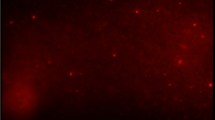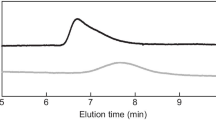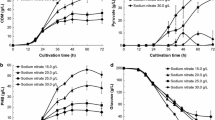Abstract
Haloarchaea is an important group of polyhydroxyalkanoate (PHA)-accumulating organisms. However, few promising haloarchaeal species for economical and efficient PHA production have been reported. Here, we first discovered that Halogranum amylolyticum TNN58 could efficiently accumulate poly(3-hydroxybutyrate-co-3-hydroxyvalerate) (PHBV) with a high 3-hydroxyvalerate (3HV) fraction using glucose as carbon source. Briefly, transmission electron microscopy (TEM) analysis revealed the presence of a large number of PHA granules in the cells. Gas chromatography–mass spectrometry (GC-MS) and proton nuclear magnetic resonance (1H NMR) analyses showed that PHAs synthesized from glucose was PHBV. Moreover, the 3HV content reached 20.1 mol%, which is the highest 3HV fraction thus far reported, as for PHBV produced by the wild-type strains grown on unrelated carbon courses. Fermentation experiments suggested that nitrogen-limited MG medium was better than nutrient-rich NOMG and AS168 medium for PHBV production. Additionally, glucose was the most suitable carbon source among the tested carbon sources. Interestingly, PHBV accumulation was almost paralleled by cell growth and glucose consumption. By applying the fed-batch process in fermentor, the PHBV production and cell dry weight were increased by approximately eight and four times, respectively, as compared with those of the batch process in shaking flasks. The classical PHA synthase genes were successfully cloned via consensus-degenerate hybrid oligonucleotide primers (CODEHOPs) and high-efficiency thermal asymmetric interlaced (hiTAIL) PCR methods. This finding suggested that H. amylolyticum shows promising potential in the low-cost biotechnological production of PHBV after further process optimization.





Similar content being viewed by others
References
Andrei AS, Banciu HL, Oren A (2012) Living with salt: Metabolic and phylogenetic diversity of archaea inhabiting saline ecosystems. FEMS Microbiol Lett 330:1–9. doi:10.1111/j.1574-6968.2012.02526.x
Antunes A, Taborda M, Huber R, MoissI C, Nobre MF, da Costa MS (2008) Halorhabdus tiamatea sp. nov., a non-pigmented, extremely halophilic archaeon from a deep-sea, hypersaline anoxic basin of the Red Sea, and emended description of the genus Halorhabdus. Int J Syst Evol Microbiol 58:215–220. doi:10.1099/ijs.0.65316-0
Chen GQ, Wu Q (2005) The application of polyhydroxyalkanoates as tissue engineering materials. Biomaterials 26:6565–6578. doi:10.1016/j.biomaterials.2005.04.036
Cui HL, Yang X, Gao X, Xu XW (2011) Halogranum gelatinilyticum sp. nov. and Halogranum amylolyticum sp. nov., isolated from a marine solar saltern, and emended description of the genus Halogranum. Int J Syst Evol Microbiol 61:911–915. doi:10.1099/ijs.0.024976-0
Fu XZ, Tan D, Aibaidula G, Wu Q, Chen JC, Chen GQ (2014) Development of Halomonas TD01 as a host for open production of chemicals. Metab Eng 23:78–91. doi:10.1016/j.ymben.2014.02.006
Han J, Lu Q, Zhou L, Zhou J, Xiang H (2007) Molecular characterization of the phaEC Hm genes, required for biosynthesis of poly(3-hydroxybutyrate) in the extremely halophilic archaeon Haloarcula marismortui. Appl Environ Microbiol 73:6058–6065
Han J, Hou J, Liu H, Cai S, Feng B, Zhou J, Xiang H (2010a) Wide distribution among halophilic archaea of a novel polyhydroxyalkanoate synthase subtype with homology to bacterial type III synthases. Appl Environ Microbiol 76:7811–7819. doi:10.1128/AEM.01117-10
Han J, Li M, Hou J, Wu L, Zhou J, Xiang H (2010b) Comparison of four phaC genes from Haloferax mediterranei and their function in different PHBV copolymer biosyntheses in Haloarcula hispanica. Saline Syst 6:9. doi:10.1186/1746-1448-6-9
Han J, Zhang F, Hou J, Liu X, Li M, Liu H, Cai L, Zhang B, Chen Y, Zhou J, Hu S, Xiang H (2012) Complete genome sequence of the metabolically versatile halophilic archaeon Haloferax mediterranei, a poly(3-hydroxybutyrate-co-3-hydroxyvalerate) producer. J Bacteriol 194:4463–4464. doi:10.1128/JB.00880-12
Han J, Hou J, Zhang F, Ai G, Li M, Cai S, Liu H, Wang L, Wang Z, Zhang S, Cai L, Zhao D, Zhou J, Xiang H (2013) Multiple propionyl coenzyme A-supplying pathways for production of the bioplastic poly(3-hydroxybutyrate-co-3-hydroxyvalerate) in Haloferax mediterranei. Appl Environ Microbiol 79:2922–2931. doi:10.1128/AEM.03915-12
Han J, Wu LP, Hou J, Zhao D, Xiang H (2015) Biosynthesis, characterization, and hemostasis potential of tailor-made poly(3-hydroxybutyrate-co-3-hydroxyvalerate) produced by Haloferax mediterranei. Biomacromolecules. doi:10.1021/bm5016267
Hezayen FF, Rehm BHA, Eberhardt R, Steinbüchel A (2000) Polymer production by two newly isolated extremely halophilic archaea: Application of a novel corrosion-resistant bioreactor. Appl Microbiol Biotechnol 54:319–325
Jendrossek D, Pfeiffer D (2014) New insights in the formation of polyhydroxyalkanoate granules (carbonosomes) and novel functions of poly(3-hydroxybutyrate). Environ Microbiol 16:2357–2373. doi:10.1111/1462-2920.12356
Koller M, Hesse P, Bona R, Kutschera C, Atlić A, Braunegg G (2007) Potential of various archae- and eubacterial strains as industrial polyhydroxyalkanoate producers from whey. Macromol Biosci 7:218–226
Lee SY (2006) Deciphering bioplastic production. Nat Biotechnol 24:1227–1229. doi:10.1038/nbt1006-1227
Legat A, Gruber C, Zangger K, Wanner G, Stan-Lotter H (2010) Identification of polyhydroxyalkanoates in Halococcus and other haloarchaeal species. Appl Microbiol Biotechnol 87:1119–1127. doi:10.1007/s00253-010-2611-6
Li T, Chen XB, Chen JC, Wu Q, Chen GQ (2014) Open and continuous fermentation: Products, conditions and bioprocess economy. Biotechnol J 9:1503–1511. doi:10.1002/biot.201400084
Liu YG, Chen Y (2007) High-efficiency thermal asymmetric interlaced PCR for amplification of unknown flanking sequences. Biotechniques 43:649-650, 652, 654 passim
Lu Q, Han J, Zhou L, Zhou J, Xiang H (2008) Genetic and biochemical characterization of the poly(3-hydroxybutyrate-co-3-hydroxyvalerate) synthase in Haloferax mediterranei. J Bacteriol 190:4173–4180. doi:10.1128/JB.00134-08
Luzier WD (1992) Materials derived from biomass/biodegradable materials. Proc Natl Acad Sci U S A 89:839–842
Meng DC, Shen R, Yao H, Chen JC, Wu Q, Chen GQ (2014) Engineering the diversity of polyesters. Curr Opin Biotechnol 29:24–33. doi:10.1016/j.copbio.2014.02.013
Pötter M, Madkour MH, Mayer F, Steinbüchel A (2002) Regulation of phasin expression and polyhydroxyalkanoate (PHA) granule formation in Ralstonia eutropha H16. Microbiology 148:2413–2426
Romano I, Poli A, Finore I, Huertas FJ, Gambacorta A, Pelliccione S, Nicolaus G, Lama L, Nicolaus B (2007) Haloterrigena hispanica sp. nov., an extremely halophilic archaeon from Fuente de Piedra, southern Spain. Int J Syst Evol Microbiol 57:1499–1503. doi:10.1099/ijs.0.64895-0
Sankhla IS, Bhati R, Singh AK, Mallick N (2010) Poly(3-hydroxybutyrate-co-3-hydroxyvalerate) co-polymer production from a local isolate, Brevibacillus invocatus MTCC 9039. Bioresour Technol 101:1947–1953. doi:10.1016/j.biortech.2009.10.006
Sim SJ, Snell KD, Hogan SA, Stubbe J, Rha C, Sinskey AJ (1997) PHA synthase activity controls the molecular weight and polydispersity of polyhydroxybutyrate in vivo. Nat Biotechnol 15:63–67. doi:10.1038/nbt0197-63
Soppa J (2005) From replication to cultivation: Hot news from Haloarchaea. Curr Opin Microbiol 8:737–744. doi:10.1016/j.mib.2005.10.012
Stubbe J, Tian J, He A, Sinskey AJ, Lawrence AG, Liu P (2005) Nontemplate-dependent polymerization processes: Polyhydroxyalkanoate synthases as a paradigm. Annu Rev Biochem 74:433–480. doi:10.1146/annurev.biochem.74.082803.133013
Tan D, Xue YS, Aibaidula G, Chen GQ (2011) Unsterile and continuous production of polyhydroxybutyrate by Halomonas TD01. Bioresour Technol 102:8130–8136. doi:10.1016/j.biortech.2011.05.068
Tan D, Wu Q, Chen JC, Chen GQ (2014a) Engineering Halomonas TD01 for the low-cost production of polyhydroxyalkanoates. Metab Eng 26C:34–47. doi:10.1016/j.ymben.2014.09.001
Tan GY, Chen CL, Ge L, Li L, Wang L, Zhao L, Mo Y, Tan SN, Wang JY (2014b) Enhanced gas chromatography-mass spectrometry method for bacterial polyhydroxyalkanoates analysis. J Biosci Bioeng 117:379–382. doi:10.1016/j.jbiosc.2013.08.020
Wainø M, Tindall BJ, Ingvorsen K (2000) Halorhabdus utahensis gen. nov., sp. nov., an aerobic, extremely halophilic member of the Archaea from Great Salt Lake, Utah. Int J Syst Evol Microbiol 50:183–190
Wang GH, Xiao JH, Xiong TL, Li Z, Murphy RW, Huang DW (2013) High-efficiency thermal asymmetric interlaced PCR (hiTAIL-PCR) for determination of a highly degenerated prophage WO genome in a Wolbachia strain infecting a fig wasp species. Appl Environ Microbiol 79:7476–7481. doi:10.1128/AEM.02261-13
Wang Y, Yin J, Chen GQ (2014) Polyhydroxyalkanoates, challenges and opportunities. Curr Opin Biotechnol 30:59–65. doi:10.1016/j.copbio.2014.06.001
Yin J, Chen JC, Wu Q, Chen GQ (2014a) Halophiles, coming stars for industrial biotechnology. Biotechnol Adv. doi:10.1016/j.biotechadv.2014.10.008
Yin J, Fu XZ, Wu Q, Chen JC, Chen GQ (2014b) Development of an enhanced chromosomal expression system based on porin synthesis operon for Halomonas sp. Appl Microbiol Biotechnol 98:8987–8997. doi:10.1007/s00253-014-5959-1
Zhao D, Cai L, Wu J, Li M, Liu H, Han J, Zhou J, Xiang H (2013) Improving polyhydroxyalkanoate production by knocking out the genes involved in exopolysaccharide biosynthesis in Haloferax mediterranei. Appl Microbiol Biotechnol 97:3027–3036
Acknowledgments
We thank Prof. Heng-Lin Cui from Jiangsu University for the donation of the strain Halogranum amylolyticum TNN58. This work was supported by grant from the General Project of Beijing Municipal Education Commission (SQKM201311417003), the National Basic Research Program of China (973 Program) (2012CB725202),the National Natural Science Foundation of China (21276110), the Priority Academic Program Development of Jiangsu Higher Education Institutions and the 111 Project (No.111-2-06).
Conflict of interest
The authors declare that they have no conflict of interest.
Author information
Authors and Affiliations
Corresponding authors
Rights and permissions
About this article
Cite this article
Zhao, YX., Rao, ZM., Xue, YF. et al. Poly(3-hydroxybutyrate-co-3-hydroxyvalerate) production by Haloarchaeon Halogranum amylolyticum . Appl Microbiol Biotechnol 99, 7639–7649 (2015). https://doi.org/10.1007/s00253-015-6609-y
Received:
Revised:
Accepted:
Published:
Issue Date:
DOI: https://doi.org/10.1007/s00253-015-6609-y




